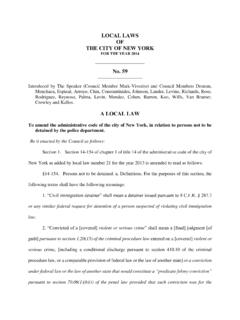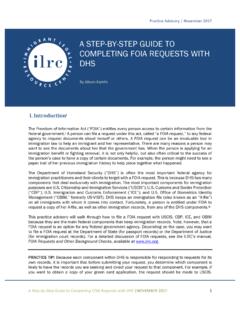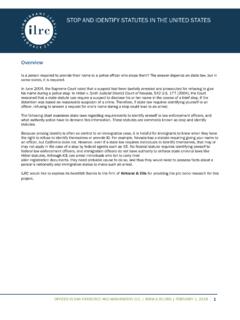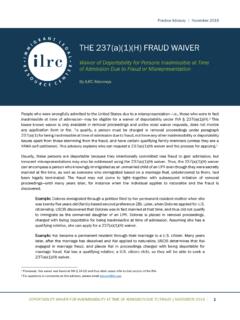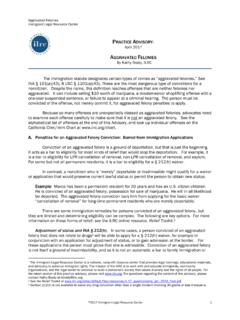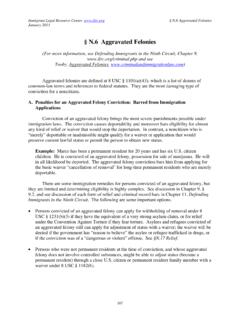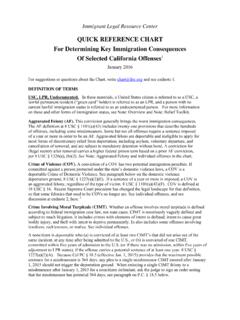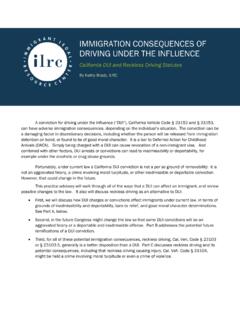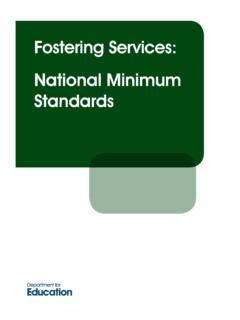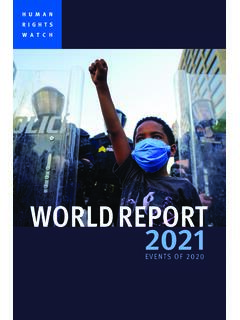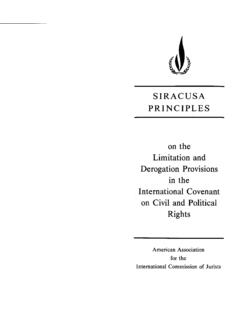Transcription of UNDERSTANDING I-212S FOR INADMISSIBILITY RELATED …
1 Practice Advisory | March 2020 UNDERSTANDING I-212S FOR INADMISSIBILITY RELATED TO prior removal ORDERS | MARCH 2020 1 I. Introduction In order to qualify for permanent resident status in the United States and most temporary (nonimmigrant) visas, applicants must prove that they are admissible under section 212 of the Immigration and Nationality Act (INA). Among the grounds of INADMISSIBILITY are bars to admission after a removal order has been executed; and after a person has re-entered unlawfully after accruing over one year of unlawful presence or after a prior order of removal .
2 See INA 212(a)(9)(A), (C). This practice advisory explains when and how the INADMISSIBILITY grounds under INA 212(a)(9)(A) and 212(a)(9)(C) can be overcome by filing Form I-212, Application for Permission to Reapply for Admission into the United States After Deportation or removal , sometimes referred to as a waiver or consent to reapply. The I-212 is not technically a waiver of INADMISSIBILITY , as an approved I-212 provides for an exception to these grounds of INADMISSIBILITY rather than a waiver.
3 1 Nonetheless, as a practical matter an I-212 has the effect of allowing a person to qualify for admission despite being inadmissible, much like a waiver. This advisory will cover the purpose of an I-212 consent to reapply, how to determine if your client needs one, and how to prepare the application packet. It will also discuss certain special circumstances, such as how a grant of Temporary Protected Status (TPS) or advance parole may affect the need for an I-212, or when a conditional I-212 may be filed for someone who will be seeking a provisional waiver and consular processing.
4 This advisory assumes a basic knowledge of the process of family-based immigration, the grounds of INADMISSIBILITY , and how to assess whether a client is eligible for immigration relief. Guidance on these topics can be accessed through various other ILRC publications and II. What is the Purpose of an I-212? An I-212 can serve two general purposes:3 (1) Address INADMISSIBILITY RELATED to a removal order: An I-212 can overcome INADMISSIBILITY under INA 212(a)(9)(A), which is triggered for a certain number of years when a person is either physically removed from the United States pursuant to a removal order or otherwise departs while a removal order is UNDERSTANDING I-212S FOR INADMISSIBILITY RELATED TO prior removal ORDERS AND THE PERMANENT BAR By Aruna Sury and Ariel Brown UNDERSTANDING I-212S FOR INADMISSIBILITY RELATED TO prior removal ORDERS AND THE PERMANENT BAR 2 UNDERSTANDING I-212S FOR INADMISSIBILITY RELATED TO prior removal
5 ORDERS | MARCH 2020 outstanding, thereby executing the order. If granted, the I-212 allows that person to seek admission to the United States even though they have not waited the required period of time after a removal . (2) Address INADMISSIBILITY RELATED to the permanent bar: Once a person has been outside the United States for at least 10 years, an I-212 can overcome the permanent bar under INA 212(a)(9)(C), which is triggered when a person enters or tries to enter the without inspection after being unlawfully present for over one year or after a removal order.
6 Unlike 212(a)(9)(A) INADMISSIBILITY , an I-212 is always needed for INADMISSIBILITY under 212(a)(9)(C), and filing the application does not allow the noncitizen to skip the required ten years outside the country. In sum, an approved I-212 allows an applicant for admission to overcome INADMISSIBILITY under 212(a)(9)(A) or 212(a)(9)(C). An I-212 to address INADMISSIBILITY under 212(a)(9)(A) allows someone to avoid the time bars; an I-212 to address INADMISSIBILITY under 212(a)(9)(C) allows someone to overcome the permanent bar, meaning they will still have to wait the ten years outside the country, but can eventually come back if the I-212 is approved instead of being permanently barred.
7 Failure to foresee the need for an I-212 could result in the denial of your client s application, or, at a minimum, significantly delay the Consequently, it is very important to determine at the outset whether your client needs and qualifies for an I-212. III. Determining if Your Client Needs an I-212 As mentioned above, an I-212 can allow someone to overcome the INADMISSIBILITY grounds under INA 212(a)(9)(A) and 212(a)(9)(C). Therefore, the first step is to determine if your client falls under one of these grounds (see Section A below).
8 If they do, the next step is to determine whether the I-212 is the correct form to use in your client s situation and whether any special circumstances apply to them (discussed in Sections B and C below). Note an I-212 generally contemplates that the applicant is outside the United States, although in Section C we address some limited situations in which someone presently within the United States might be able to request an I-212, either preemptively (via a conditional I-212) or after-the-fact (via a nunc pro tunc I-212).
9 WARNING: An I-212 only addresses the INADMISSIBILITY provisions of INA 212(a)(9)(A) and (C). It does not address any other INADMISSIBILITY provisions that may also apply to your client. Before you decide to file an application for admission, you must thoroughly screen for other INADMISSIBILITY provisions that may apply and whether your client qualifies for a waiver or exemption of those provisions. For example, a RELATED ground of INADMISSIBILITY for individuals who have a prior order that was entered in absentia is INA 212(a)(6)(B), which imposes a five-year bar from the date an individual with an in absentia removal order departs the country.
10 If your client has a prior in absentia order, and does not have grounds to reopen their proceedings (see Section C), they will be subject to INADMISSIBILITY under INA 212(a)(6)(B). An I-212 will not cure INADMISSIBILITY under INA 212(a)(6)(B), which can only be overcome during the five years that it applies by proving that there was reasonable cause for their failure to appear. UNDERSTANDING I-212S FOR INADMISSIBILITY RELATED TO prior removal ORDERS AND THE PERMANENT BAR UNDERSTANDING I-212S FOR INADMISSIBILITY RELATED TO prior removal ORDERS | MARCH 2020 3 A.
